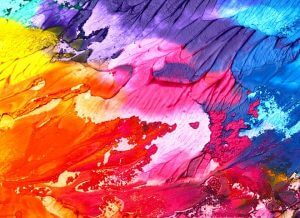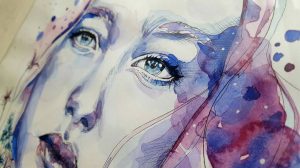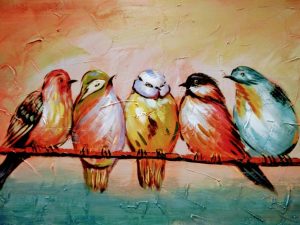
In art appreciation, mood is the general atmosphere, or state of mind and feelings, that a work of art generates. For example, the mood of a painting could be disturbing or tranquil, dark or energetic. The mood of a painting is usually determined by the artists use of colour, brush strokes and other stylistic choices.
This is because of the expressive potential that colour has. We feel colour. How or what we feel about it varies from person to person. Colours are very directly relatable to human feelings or with certain sensations and have lots of power in that context. Some colours give us a sense of serenity and calm. These usually lie within the blue side of the spectrum, known as the cool side. Others induce passion; these lie within the red spectrum-which includes orange and yellow, known as the warm side.
Colour psychology is a very important tool used by artists, interior decorators, and as a marketing mechanism in many industries.
When an artist knows what mood a particular colour elicits, she would be better able to make the right colour decision for her painting or design.
In this article, we have created a colour guide for beginner artists. Read on, and find out the colours that apply to the mood you want your design to evoke.
Red.
Associated with energy, war, danger, strength, power, determination as well as passion, desire, and love. Enhances human metabolism, increases respiration rate, and raises blood pressure. It attracts attention more than any other colour, at times signifying danger.
Alternate meanings: In some Eastern cultures, red symbolises good fortune and prosperity and is the colour worn by brides on their wedding day. Worldwide, red has been associated with various political movements and has symbolised revolution.
In branding: Red often communicates strength, confidence and power, and is a highly visible colour.

Orange.
It combines the warm energy of red and the cheerfulness of yellow. Associated with joy, sunshine, and the tropics.
Represents enthusiasm, fascination, happiness, creativity, determination, attraction, success, energy, optimism, activity encouragement, and stimulation.
Alternate meanings: In India, saffron, a certain yellowish shade of orange, is considered sacred. In Japan, orange is the colour that symbolises love.
In branding: Orange often represents youthfulness and creativity. Gold, which is a type of orange or yellow, depending on its hue, is a symbol of luxury or high quality.
Yellow
As the colour of sunshine, yellow often communicates happiness, cheerfulness, friendliness, and the freshness of spring. Produces a warming effect, arouses cheerfulness, stimulates mental activity, and generates muscle energy.
Bright, pure yellow is an attention getter, which is the reason taxicabs are painted this colour. When overused, yellow may have a disturbing effect. It can also signal warning or caution in certain contexts. Some variations (especially desaturated and greenish yellows) can look sickly or unpleasant; historically, yellow has sometimes been associated with illness, quarantine and cowardice.
Studies show that babies cry more and people are more likely to lose their temper in yellow rooms.
Alternate meanings: In some Eastern and Asian cultures, yellow is associated with royalty or high rank. In parts of Africa and Latin America, yellow is the traditional colour of mourning.
In branding: Pure/bright yellow does a great job of attracting attention, but can be visually disturbing or even hard to see (for instance, white text against a bright yellow background or vice versa) if not used with care.
Green
Colour of nature. It symbolizes growth, harmony, freshness, and fertility. Strong emotional correspondence with safety. Dark green is also commonly associated with money. It has great healing power. Green suggests stability and endurance.
Alternate meanings: Among cultures that practice Islam, green is a sacred colour. Green is also associated with Ireland and, by extension, St. Patricks Day and lucky four-leaf clovers.
In branding: Brands or product that wants to come across as green (in the sense of natural, healthy, sustainable, environmentally friendly, organic, etc.) often use nature-inspired colours like green and brown.
Blue
 Colour of the sea. It is often associated with depth and stability. It symbolises trust, loyalty, wisdom, confidence, intelligence, faith, and truth. Considered beneficial to the mind and body. Slows human metabolism and produces a calming effect. Strongly associated with tranquillity and calmness.Used to symbolise piety and sincerity. In some contexts, it can represent sadness or depression.
Colour of the sea. It is often associated with depth and stability. It symbolises trust, loyalty, wisdom, confidence, intelligence, faith, and truth. Considered beneficial to the mind and body. Slows human metabolism and produces a calming effect. Strongly associated with tranquillity and calmness.Used to symbolise piety and sincerity. In some contexts, it can represent sadness or depression.
Alternate meanings: In Middle Eastern cultures, blue has traditionally represented protection against evil. Because of its association with the heavens, blue symbolises immortality and/or spirituality in many cultures.
In branding: Blue is used widely and one of the most versatile colours. It is used to communicate trustworthiness, security, and stability. Dark or navy blue is a particularly popular choice for corporate contexts since it is perceived to have serious, conservative, and professional qualities.
Purple
It combines the stability of blue and the energy of red. Associated with royalty. It symbolises power, nobility, luxury, and ambition. Conveys wealth and extravagance. Associated with wisdom, dignity, independence, creativity, mystery, and magic.
Alternate meanings: In many cultures around the world, purple represents nobility or wealth; however, in Thailand and parts of South America, the colour is associated with mourning.
In branding: Darker shades of purple often still symbolise luxury or opulence, while lighter/brighter shades can come across feminine.
White
As the colour of light and snow, white often represents purity, innocence, goodness, or perfection, light and purity. Considered to be the colour of perfection. Signifies safety, purity, and cleanliness. Usually has a positive connotation. Can represent a successful beginning. Depicts faith and purity, but it can also come across as stark or sterile.
Alternate meanings: In China, white is the colour of mourning. It represents peace across many cultures a white flag is a universal symbol of truce or surrender.
In branding: White often communicates simplicity or a clean, modern quality. Designers seeking a minimalist aesthetic will frequently use much white.
Black
The symbol of grief. Like red, black has many (sometimes opposing) meanings. It can represent power, luxury, elegance, formality sophistication, and exclusivity. On the other hand, it can symbolise death, evil, or mystery. It usually has a negative connotation. It denotes strength and authority; it is considered to be a very formal, elegant, and prestigious colour. In apparel, black communicates formality (black tie parties) or mourning/sorrow (as the colour traditionally worn to funerals).
Alternate meanings: In some Asian and Latin American cultures, black is considered a masculine colour. In Egypt, black signifies rebirth. Across many cultures, the colour is associated with magic, superstition, or bad luck or, similarly, the unexplainable or unknown.
In branding: Black is so widely used that it is almost a neutral, though it can still communicate the meanings above depending on context. Many designs are simply black and white, whether thats a deliberate choice or just to save money on colour printing. Colours always look brighter and more intense against black.
Brown
Reliability, stability, friendship, sadness, warmth, comfort, security, natural, organic.
In some societies, brown denotes mourning.
 There you have it, a colour/mood chart for beginner artists. Do you want to give your design a calm and serious impression or fun and playful, or maybe intense and passionate? Now you know what colour to use for the mood you are trying to arouse.
There you have it, a colour/mood chart for beginner artists. Do you want to give your design a calm and serious impression or fun and playful, or maybe intense and passionate? Now you know what colour to use for the mood you are trying to arouse.
Reference:
Color Theory – Tips And Inspiration By Canva



